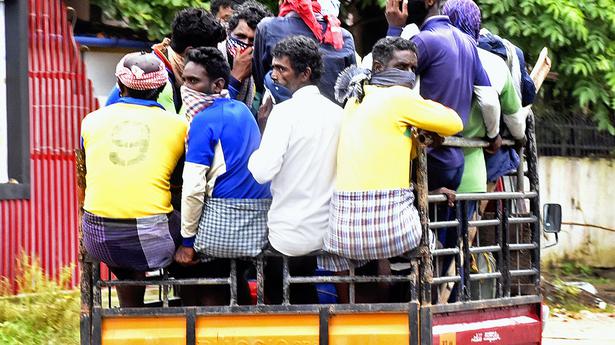The Uzhavar Sandhais, a flagship programme of the M. Karunanidhi government, have predictably been revived with this DMK government taking power. While they serve a solid purpose for both consumer and farmer, many more improvements can be made to the scheme, users point out
The Uzhavar Sandhais, a flagship programme of the M. Karunanidhi government, have predictably been revived with this DMK government taking power. While they serve a solid purpose for both consumer and farmer, many more improvements can be made to the scheme, users point out
After having lived in Chennai for years, Damayanthi, a home-maker in her 40s, has not been happy about relocating to Hosur. But one thing in Hosur that has impressed her is the Uzhavar Sandhai (farmers’ market), a platform to link farmers and consumers. “I get fresh vegetables at cheap rates,” she says at the bustling market on a weekday. Another consumer at Hosur points out that “you save at least 5% in cost.”
Launched in January 2000, the Hosur Uzhavar Sandhai was among the first markets established by the Agricultural Marketing and Agri Business Department, which comes under the Agriculture Department. It is one of the large functional Uzhavar Sandhais. On an average, it handles around 47.7 tonnes of vegetables and draws nearly 5,900 consumers every day.
Going by the official data for the first half of the current financial year, it is one of the three markets whose daily transactions range from ₹15 lakh to ₹20 lakh. The others are Singanallur and R.S. Puram in Coimbatore district. However, the Tiruppur South Uzhavar Sandhai tops the list of 181 markets all over the State with the daily arrival of about 92 tonnes of vegetables and ₹24 lakh in sales.
The market at Sunguvar Chatram, near Sriperumpudur, which is deserted on a Tuesday.
| Photo Credit: The Hindu
R.K. Sharma, a naval officer, has been visiting the Nanganallur Uzhavar Sandhai for eight years. “Regularly, I compare the quality and prices at the Sandhai with those in the private market. I am thoroughly satisfied with what I get here,” he says.
Of course, the Sandhai in Nanganallur is modest: it receives around 3.6 tonnes of vegetables daily and sales touch a little over ₹1 lakh. Unlike the one in Hosur, which has at least 220 farmers on its rolls, the Nanganallur Uzhavar Sandhai does not have any farmer to support it. Members of Pavalamalli self-help group manage it.
Effectively, nine persons are part of the Uzhavar Sandhai, procuring vegetables from bigger markets, including the Koyambedu wholesale market. It is not difficult to find out the reasons for the absence of farmers. “The impact of urbanisation is such that in the close vicinity of Nanganallur, you don’t find any farmer,” an official says.
V. Shanthi, who has been selling vegetables for 12 years at Nanganallur and heads the SHG, says she goes to Koyambedu in the early hours of the day so that she can start selling the vegetables by 7 a.m. at Nanganallur. Apart from the support of her husband, she does not get any help from her three sons, two of whom are engineering graduates.
But what worries her more is the lean patch that she has been experiencing for over two years. “Since the outbreak of COVID-19, there has been a substantial fall in sales. Before the pandemic, the daily earnings invariably exceeded ₹10,000. Now, they are down by at least ₹3,000,” she points out.
Better ambience
The Nanganallur Uzhavar Sandhai is not alone in this plight. It is the same story in at least half of these markets whose average daily sales fall in the slab of ₹1 lakh-₹5 lakh. In terms of the volume of business, it is one of the 47 Uzhavar Sandhais which receive less than 5 tonnes of vegetables a day.
Marginally better than Nanganallur is the one at Pallavaram, about 7 km to the south. But this Sandhai sports better ambience with a paved passage and a provision for car parking. It is for these reasons that Navratan, a local jeweller, has been visiting the Pallavaram Sandhai since its inception in November 2000.
Interestingly, Pallavaram was the 100th in the series and declared open by the then Chief Minister M. Karunanidhi, who inaugurated the first at Anna Nagar, Madurai, exactly a year earlier. Be it Hosur or Pallavaram, many Uzhavar Sandhais have regular clients among hostels, restaurants and canteens.
Farmers say the Sandhais serve more than one purpose. Kubendran, who lives in Arcot town and manages 16 acres at Maalaimedu, a village about 15 km from the town, has been supplying vegetables to Ranipet for the last six years. His profit ranges from 5% to 20%.
M. Botharaj, a farmer who travels 13 km from his village to the Dharmapuri Uzhavar Sandhai, does not mind the commute because of good returns. Will he not get higher returns in a private retail market? “In that case, I will have to pay rent for my shop, apart from other monetary contributions to the local community. But, at the Uzhavar Sandhai [where farmers do not have to pay rent], I am saving that much,” says the farmer, who has been selling vegetables for the last three years.
In the case of farmer-producers organisations and SHGs which want to have shops in permanent slots at the Sandhais, a monthly rent of ₹1,000-₹1,500 is being charged and such shops can constitute 10% of the total. Otherwise, the slots are allotted to farmers by lot at periodic intervals.
But there are Uzhavar Sandhais that do not justify their existence in terms of the arrival of vegetables, patronage and the value of business. A visit to a market at Sunguvar Chatram, near Sriperumpudur, on a Tuesday was quite revealing — it was deserted. Local officials were quick to say, “If you come on Wednesday, you will find a number of people at this Sandhai.”
Only a handful of consumers could be spotted early this week at the Zamin Royapettah Uzhavar Sandhai near Chormpet. A strange feature is that no farmer is seen selling vegetables. “They come here around 11 a.m. or noon from places such as Padappai and Thirukazhukundram,” says a person in charge of the security of the market.
There are eight farmers who supply their produce. They divide the daily earnings equally among themselves, he says. As per an estimate, there are 16 Uzhavar Sandhais, earning less than ₹50,000 a day. Thirukazhukundram in Chengalpattu district and Jeyankondam in Ariyalur did a daily business of not even ₹10,000 in the first half of this year. The Jeyankondam market and the one in neighbouring Ariyalur have only one or two farmers participating in them. In fact, the laggards are everywhere in the State. All these call for a closer scrutiny by the authorities who have embarked on a programme to revamp the scheme.
Conscious of the chinks in the scheme and the emergence of challenges such as the online grocery sector, the government, which has been paying more attention to Uzhavar Sandhais with the DMK’s return to power in May 2021, has drawn up plans to tone up the scheme. Of 10 additional Sandhais to be opened, one — Thalavadi in Erode — was commissioned by Chief Minister M.K. Stalin.
Nine more will start operation in a month or two. Renovation of 50 Sandhais has been taken up at a cost of ₹12.5 crore. Work has been completed in all. However, in Cuddalore, as the construction of additional shops and the realignment of the existing shops are in progress, the market will be ready in a month.
Digital boards, displaying the prices, have been put up at 20 Sandhais, and the rest will be covered by November-end. Cashless transactions are taking place at many places. To cater to the office-goers, Uzhavar Sandhais have been allowed to function even at evening; the system is being tried out in nine districts.
The sale of non-perishable items such as millets, value-added products, mushroom, and egg is permitted. Attention is paid to those areas which report low arrival of vegetables. Every Saturday, officials of the Agricultural Marketing and Agri Business Department and the Horticulture Department visit source-villages to find out the problems.
Composting units ready
To resolve the problem of accumulation of vegetable waste, composting units are getting ready at many places. In Ranipet, a unit, costing ₹11 lakh, is set for inauguration. Besides, a drive is under way to get certification from the Food Safety and Standards Authority of India (FSSAI) for all the Sandhais to be declared Clean and Fresh Fruit and Vegetable Markets. In August, the first Uzhavar Sandhai — Anna Nagar in Madurai — became the first in the State to get the certificate. Since then, many have received it.
The authorities are nudging farmers to take to different methods of marketing, including home delivery, a trend that has gained currency in the post-pandemic years. This is happening informally at Pallavaram.
As a sequel to the announcement in the agriculture budget last year, the authorities are putting finishing touches to the plan to sell vegetables and fruits on vehicles in the districts of Chengalpattu, Coimbatore, Salem, Tiruchi, Tiruppur and Tiruvallur at a cost of ₹60 lakh. Under the scheme, a subsidy of 40% of the vehicle cost, or ₹2 lakh, whichever is less, will be provided to rural youth to purchase the vehicle. Fabrication of 20 vehicles has been completed.
More than all, the government has an ambitious plan of entering the online segment through the launch of e- Uzhavar Sandhai by involving farmer-producer organisations and start-ups. Making use of the recently renovated Ambattur Uzhavar Sandhai, the officials are planning to cover areas, including Anna Nagar and Mogappair, through the mobile service.
Even as all the measures are being taken to fine-tune their functioning, the markets do face issues of cleanliness, location and sustainability. Not all those who sell the vegetables are farmers. There is a section of traders which has managed to be part of the overall system. An official says a recent drive to remove such persons at Sooramangalam in Salem had run into resistance.
M. Thyagarajan, president of the Koyambedu Vegetable, Fruit and Flower Markets Shop Owners Welfare Association, feels that the prices at Uzhavar Sandhais can still be fixed lower and the farmers need to follow closely what is happening in the private wholesale and retail markets. “The Uzhavar Sandhais have a lot of potential to improve their working.”
This trader is not the only one to realise the need for a bigger role for Uzhavar Sandhais. The Damayanthis and the Sharmas know this very well as after all they are among three lakh consumers being served daily by the Sandhais, which ensure livelihood for 7,500 farmers every day by receiving around 1,900 tonnes of vegetables and fruits and making ₹6.5 crore in sales. These consumers are keen that the space being enjoyed by these markets grow larger.




